Dr. Strange, Part II: Becoming Sorcerer Supreme and Dying in the Englehart Era
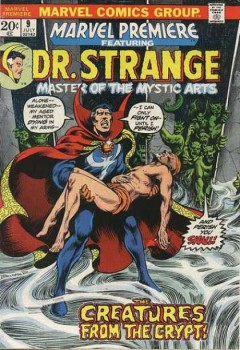 In a blog post of some weeks ago, looked at the one of my favorite Dr. Strange periods, when they’d established his overall mythos. The early 1970s was another kick-ass period for Dr. Strange, when the Master of the Mystic Arts became the Sorcerer Supreme.
In a blog post of some weeks ago, looked at the one of my favorite Dr. Strange periods, when they’d established his overall mythos. The early 1970s was another kick-ass period for Dr. Strange, when the Master of the Mystic Arts became the Sorcerer Supreme.
In 1971, after the end of the series Strange Tales, Marvel’s Master of the Mystic Arts found a home in Marvel Premiere with issue #3. Marvel was just beginning an eerie period that mirrored the monster movie craze of the 1970s.
This period brought into prominence Marvel’s werewolves, zombies, Morbius the Living Vampire, Ghost Rider, Son-of-Satan, Dracula, Satana, Blade, and even ended up turning one of the X-Men into a furry monster. This tone seeped into Dr. Strange too.
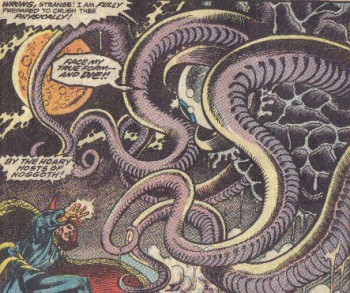 From issue #3 to issue #8 of Marvel Premiere, writers Archie Goodwin and Gardner Fox (yes, the Gardner Fox who invented the Justice Society in the 1940s) imported the pulp tone and concepts of Robert E. Howard into Dr. Strange.
From issue #3 to issue #8 of Marvel Premiere, writers Archie Goodwin and Gardner Fox (yes, the Gardner Fox who invented the Justice Society in the 1940s) imported the pulp tone and concepts of Robert E. Howard into Dr. Strange.
Strange fought ancient sleeping monstrosities pre-dating the birth of humanity like Sligguth, N’Gabthoth, Dagoth, and Kathulos, all of whom were servants of the dreaded Shuma-Gorath. However, this was just set up for the main event.
Steve Englehart took over the writing chores in Marvel Premiere #9, joined by artist Frank Brunner. Here, Strange raced to help his dying master and teacher the Ancient One, right at the time when Shuma-Gorath was trying to invade our dimension. Strange doesn’t understand that the Ancient One must die. In trying to save the Ancient One, Strange weakens the him enough that Shuma-Gorath enters the mind of the old Sorcerer Supreme.
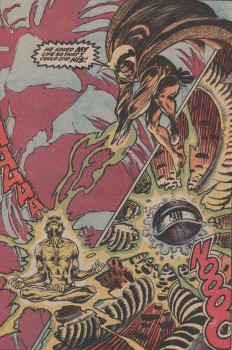 Strange enters the mind of his master to fight Shuma-Gorath, only to realize in the end that he must kill the Ancient One to stop Shuma-Gorath. This is no easy task. The Ancient One saved not only Strange’s life and soul when he took him as an apprentice, but he made him the moral man he is.
Strange enters the mind of his master to fight Shuma-Gorath, only to realize in the end that he must kill the Ancient One to stop Shuma-Gorath. This is no easy task. The Ancient One saved not only Strange’s life and soul when he took him as an apprentice, but he made him the moral man he is.
For Strange, it’s like having to kill his beloved father.
Strange gathers his courage and sacrifices the Ancient One’s ego to stop Shuma-Gorath’s entry into our world. Mourning, Strange then discovers that the Ancient One has transcended humanity and reached becoming one with the universe. This new form of the Ancient One bequeathes his last powers upon Strange, the new Sorcerer Supreme.
This is heady stuff. If you’re a Dr. Strange fan, it’s hard not to get a little verklempt at the death of the Ancient One and the elevation of Strange. But Englehart doesn’t rest on his laurels.
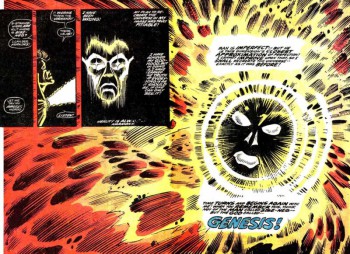 In Marvel Premiere #12, a sorcerer has found the secret to travelling into the past by magic. Strange follows to prevent disaster, and in the three issue arc, Strange as the new Sorcerer Supreme ends up witnessing the birth of the universe. Whew!
In Marvel Premiere #12, a sorcerer has found the secret to travelling into the past by magic. Strange follows to prevent disaster, and in the three issue arc, Strange as the new Sorcerer Supreme ends up witnessing the birth of the universe. Whew!
Time to take a break, right? I mean, Strange entered the mind of the Ancient One, extinguished his ego, witnessed him ascending to a new plane of existence and then participated in the creation of the universe. Time for a beer, right? Nope.
On the strength of his Marvel Premiere run, Marvel decided to give Dr. Strange his own book in 1974, with Englehart and Brunner on deck for the first 5-issue arc. Englehart starts the 81-issue series by killing Dr. Strange.
Strange gets stabbed in the back by the Silver Dagger, and his soul is absorbed into the psychedelic world inside the Orb of Agamotto. Definitely an unconventional way to start a series!
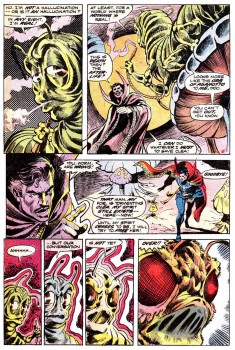 But of course, Dr. Strange refuses to die. He has to protect the world and his loved ones from the Silver Dagger. So his soul fights its way by magical skill and insight and willpower through the Alice-in-Wonderland madness inside the Orb. It’s not enough. But Strange is not the same man he was even weeks ago.
But of course, Dr. Strange refuses to die. He has to protect the world and his loved ones from the Silver Dagger. So his soul fights its way by magical skill and insight and willpower through the Alice-in-Wonderland madness inside the Orb. It’s not enough. But Strange is not the same man he was even weeks ago.
He watched his teacher die, without fear. He understands that death is a part of life and that although all men fight it, it is only fear that makes them fight. He stops fearing death, makes himself ready to die and accepts Death.
Everything disappears. Nothingness surrounds Strange. Then Ancient One appears to him, congratulating him on passing the first test that every new Sorcerer Supreme must face: to expunge the fear of death. From this moment onward, Strange is ageless, like his master before him. That’s kind of big, character-wise and philosophically.
After this huge spiritual climax, returning to physical form to defeat the Silver Dagger feels like satisfying denouement, like when Frodo cleans up the Shire.
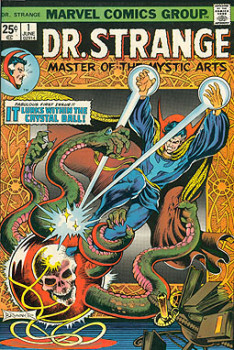 The Dr. Strange of the Lee-Ditko era introduced the flavor of eastern mysticism, and psychedelic art and concepts to the world of comics. The Englehart-Brunner period added many of the deeper implications.
The Dr. Strange of the Lee-Ditko era introduced the flavor of eastern mysticism, and psychedelic art and concepts to the world of comics. The Englehart-Brunner period added many of the deeper implications.
Strange’s last act as a disciple was to kill the father in the Freudian and Jungian sense. Strange’s first act as the Sorcerer Supreme was to witness the birth of the universe and to understand time.
And the trial that launched a 15-year comic book run was to have him die and be reborn in a very non-western sense, making him essentially ageless. This is a tremendously powerful period for Dr. Strange and made him the flag-bearer for more mature and philosophical concerns in comics.
The rest of the 1970s was a good time for Dr. Strange. Frank Brunner’s beautiful art gave way to Gene Colan’s, who reinvented the artistic feel to suit a new decade. Englehart wrote the next couple of years of Dr. Strange, and his successors built on his foundations, as well as those laid down by Lee and Ditko, Fox, and Goodwin, taking what they needed from the Dread Dormammu, vampires, and the ancient evils.
The next time I talk about Dr. Strange, I’m going to take a look at a period in the late 1980s, when he lost everything.
Derek Künsken writes science fiction, fantasy and horror in Gatineau, Québec. He tweets at @derekkunsken. He’s been blogging about other comic series too. He ran a 4-part blog series on the phases of Adam Warlock (I, II, III, IV), talked about the Son-of-Satan, and looked at the Brubaker/Fraction run on The Immortal Iron Fist.
Yes! That Brunner period of Dr. Strange was awesome. For my tastes, it was my favorite run for the character. Even moreso than the Ditko stuff.
My intro to Doctor Strange was late and has been haphazard — I really appreciate this series and have been trying to buy accordingly. Is this run unavailable?
I second Theodric’s question – can you offer any guidance on how to collect all these in compilations and such?